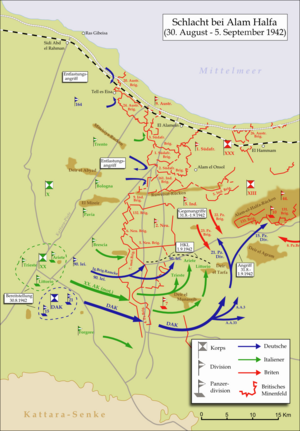Battle of Alam el Halfa
| Battle of Alam el Halfa | |||||||
|---|---|---|---|---|---|---|---|
| Part of the Western Desert Campaign of the Second World War | |||||||
 German map, Schlacht bei Alam Halfa |
|||||||
|
|||||||
| Belligerents | |||||||
|
|
|
||||||
| Commanders and leaders | |||||||
|
|
|
||||||
| Strength | |||||||
|
XIII Corps (Eighth Army): 4 divisions |
Panzer Army Africa: 6 divisions |
||||||
| Casualties and losses | |||||||
| 1,750 killed, wounded or captured 68 tanks 67 aircraft |
2,900 killed, wounded or captured 49 tanks 36 aircraft 60 guns 400 transport vehicles |
||||||
The Battle of Alam el Halfa took place between 30 August and 5 September 1942 south of El Alamein during the Western Desert Campaign of the Second World War. Panzerarmee Afrika—a German–Italian force commanded by Generalfeldmarschall Erwin Rommel—attempted an envelopment of the British Eighth Army, commanded by Lieutenant-General Bernard Montgomery. In the last major Axis offensive (Operation Brandung/Unternehmung Brandung) of the Western Desert Campaign, Rommel had planned to defeat the Eighth Army before Allied reinforcements made an Axis victory in Africa impossible.
Montgomery, who had been forewarned of Rommel's intentions by Ultra intelligence intercepts, left a gap in the southern sector of the front, knowing that Rommel planned to attack there, and deployed the bulk of his armour and artillery around Alam el Halfa Ridge, 20 miles (32 km) behind the front. In a new tactic, the tanks were used in an anti-tank role, remaining in their positions on the ridge. Montgomery intended to hold the armour back, refusing to allow them to sortie out as they had in the past.
With the attacks on the ridge failing and his supply situation precarious, Rommel ordered a withdrawal. Montgomery chose not to exploit his defensive victory, preferring to continue the methodical build up of strength for his autumn offensive, the Second Battle of El Alamein. However, the 2nd New Zealand Division, under Lieutenant-General Bernard C. Freyberg, launched an abortive attack on Italian positions, suffering heavy losses.
Rommel was to claim that British air superiority played a decisive factor in winning the battle, being unaware of British Ultra intelligence. Rommel noted that the damaging attacks had a great impact on Axis motorised forces and forced him to break off his offensive. Rommel adapted to the increasing Allied dominance in the air by keeping his forces dispersed. The price of the battle to the Axis was not just a tactical defeat and retreat. With the Alam Halfa failure, Rommel was deprived not only of the operational ability to initiate offensives, he lost the operational and tactical ability to defend the German base in Africa. Axis strategic aims in the African theatre were no longer possible.
...
Wikipedia
